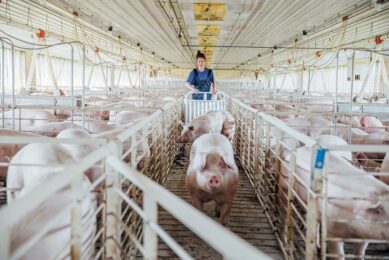CO2 anaesthetics almost ready for use
Anaesthetising male piglets using carbon dioxide is likely to become a serious alternative to castration without anaesthetics in the Netherlands.
The use of two different machines, developed by the Dutch companies NAM and Schippers respectively, offers perspectives, according to preliminary results by scientists at the Animal Sciences Group (ASG), part of Wageningen University and Research Centre (WUR).
The research was commissioned by the Dutch agriculture ministry (LNV) and the product board for livestock and meat (PVV).
Topical
As the castration issue is topical in the Netherlands, the ministry asked the ASG to carry out research into several techniques of anaesthetics, among which anaesthetics using a mix of CO2 and oxygen.
Positive outcomes in testing led to the next step: several companies were asked to develop a gas-based anaesthetics machine, meeting the scientists’ technical requirements and the market’s practical requirements.
Safety tests
The two models were tested for safety for piglets and practical use on the experimental pig farm in Sterksel, the Netherlands. A third prototype, developed at the Technical University of Delft, the Netherlands, is still being worked on.
In both existing models, the piglets are placed in a small cabin. Operating a switch allows the gas to flow into this space – a light signal will tell the user when the animal is fully anaesthetised, after which it can be castrated.
The research was commissioned by the Dutch agriculture ministry (LNV) and the product board for livestock and meat (PVV).
Topical
As the castration issue is topical in the Netherlands, the ministry asked the ASG to carry out research into several techniques of anaesthetics, among which anaesthetics using a mix of CO2 and oxygen.
Positive outcomes in testing led to the next step: several companies were asked to develop a gas-based anaesthetics machine, meeting the scientists’ technical requirements and the market’s practical requirements.
Safety tests
The two models were tested for safety for piglets and practical use on the experimental pig farm in Sterksel, the Netherlands. A third prototype, developed at the Technical University of Delft, the Netherlands, is still being worked on.
In both existing models, the piglets are placed in a small cabin. Operating a switch allows the gas to flow into this space – a light signal will tell the user when the animal is fully anaesthetised, after which it can be castrated.
In the NAM prototype, the piglet will be castrated out of the cabin, in the Schippers model, castration happens within the cabin. Both machines have a security mechanism, which makes sure the piglets can only be in the gas for a maximum of two minutes.
Treatment carriage
The machines are placed on a treatment carriage, so it can be easily transported through a pig house. It is possible to have more than one unit on a carriage for speeding up the castration process.
More detailed information regarding the experiments are expected shortly.
Last year, Dutch supermarkets decided that as from 2009, no more meat will be sold from piglets that were castrated without anaesthetics. In the end of June, the supermarkets offered to pay for whatever device will be used to anaesthetise the piglets prior to castration.
Related websites
• Animal Sciences Group
• Wageningen University and Research Centre
• Dutch Product Board for Livestock and Meat
• Dutch Ministry of Agriculture Nature and Food Quality
Subscribe here to the free Pig Progress newsletter
Related websites
• Animal Sciences Group
• Wageningen University and Research Centre
• Dutch Product Board for Livestock and Meat
• Dutch Ministry of Agriculture Nature and Food Quality
Subscribe here to the free Pig Progress newsletter











